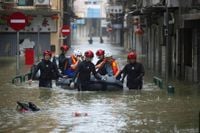Super Typhoon Ragasa, declared the strongest storm of the year, has left a devastating path across the northern Philippines, Taiwan, Hong Kong, and southern China, claiming at least 24 lives, displacing millions, and bringing some of Asia’s busiest cities to a sudden halt. In the wake of its destruction, communities are grappling with catastrophic flooding, infrastructure collapse, and the urgent need for rescue and recovery efforts.
According to The Independent, the storm’s initial impact was felt most acutely in Taiwan, where at least 14 people died and 124 remain missing after a barrier lake—formed by landslides in Hualien county—burst its banks following torrential rains. The resulting wall of water crashed into Guangfu township on September 23, 2025, sweeping away cars, inundating homes, and washing out a large bridge. The government had previously warned residents about the potential for overflow, but the storm’s deluge far exceeded expectations. Taiwan’s premier, Cho Jung-tai, has since called for an inquiry into the evacuation orders, as nearly 60 percent of Guangfu’s population had been told to seek shelter, but the tragedy could not be averted.
Rescue efforts in Taiwan ramped up quickly. The military dispatched 340 troops to assist in Hualien, and regions across the island sent their own rescue teams. However, with 17 people still missing and entire neighborhoods submerged, the challenges remain immense. As reported by CNN, a professor at National Chi Nan University, Kuo-Lung Wang, noted that the natural dam’s collapse was accelerated by the typhoon’s heavy rainfall, which was not fully anticipated in earlier risk assessments.
Ragasa’s fury was not confined to Taiwan. Earlier in the week, the northern Philippines endured the storm’s full Category 5 force. According to the Philippine Information Agency, at least three people died in northern Luzon, including a 74-year-old man trapped in a vehicle buried by mud and rocks in Benguet province and two others in Calayan town, Cagayan province. Thousands more were displaced by floods and landslides, with more than 17,500 forced from their homes and five still missing. The disaster agency also reported that at least seven fishermen died when a boat overturned off Luzon’s coast. Schools, government offices, and transport services were suspended across 29 provinces, and both ferries and domestic flights were cancelled as the storm battered the archipelago.
As Ragasa churned northwest, it maintained super typhoon strength, with maximum sustained winds of 200 km/h and gusts up to 250 km/h, according to the US Joint Typhoon Warning Center. The storm was moving at 15 km/h over very warm waters—conditions primed for further intensification, as meteorologists warned. Scientists, quoted in The Independent and CNN, have pointed out that climate change is fueling more intense and unpredictable storms in the region, with warmer seas and more moisture in the atmosphere providing extra energy for typhoons like Ragasa.
Hong Kong, a city accustomed to powerful storms, braced for Ragasa’s arrival by issuing a No 10 signal—the highest level alert. The South China Morning Post reported that authorities shut schools and public offices throughout Tuesday and Wednesday, warning that hurricane-force winds and storm surges could rival those seen during Super Typhoon Mangkhut in 2018. The Hong Kong Observatory cautioned that the weather would "deteriorate rapidly" with "gale to storm-force winds" and high swells. As the storm struck, wind gusts reached up to 168 km/h (104.39 mph), toppling trees and scaffolding, and sending waves higher than lampposts crashing onto promenades.
The impact on travel was immediate and severe. Around 700 flights were cancelled between September 23 and 24, affecting an estimated 20,000 passengers. The airport warned of significant disruption to flights from 6 pm on Tuesday until at least Thursday morning. Analysis by The Independent of Flightradar24 data showed that 86 regional and more than 30 long-haul departures were grounded, including key routes to London. Ferries and major highways also shut down, while supermarkets saw empty shelves as residents stockpiled essentials.
Across Hong Kong, at least 90 people were injured, and 885 sought refuge in temporary shelters, according to CNN. In Macao, often dubbed the world’s most densely populated city, waist-deep water flooded the streets, and storm surges of over 3 meters were recorded. The Fullerton Ocean Park Hotel in Hong Kong suffered flooding as waves shattered glass doors and swept through its lobby, though no injuries were reported. In neighboring Shenzhen, winds reached 181.44 km/h (112.4 mph), and massive waves battered coastal parks.
Southern China bore the brunt as Ragasa made landfall on September 24. Guangdong province, home to over 125 million people and major cities like Shenzhen and Guangzhou, evacuated nearly 2 million residents ahead of the storm’s arrival. Xinhua reported that over 10,000 vessels were relocated to safer waters, and more than 38,000 firefighters were placed on standby. In Zhuhai, a city of almost three million, the BBC described scenes of howling winds, flying debris, and empty roads as police patrolled with megaphones, urging residents to stay indoors. The city was brought to a standstill, with many residents taking refuge in school gymnasiums or with relatives. For some, it was the first evacuation they had experienced in decades of living in the region.
Despite the immense disruption, the region’s experience with typhoons has led to robust preparedness measures. Hong Kong’s $3.8 billion drainage network, for instance, has helped prevent the kind of catastrophic flooding that once plagued the city. Yet, as Johnny Chan, an atmospheric scientist at the Asia-Pacific Typhoon Collaborative Research Centre, told CNN, climate change means cities must continually update building codes and infrastructure to handle stronger winds, higher sea levels, and more intense storms. "Most of the building codes were designed based on the past data, but the past data would not be accurate anymore for the future," Chan warned.
As Ragasa began to weaken slightly after landfall in China, cleanup efforts got underway in the Philippines and Taiwan. But the typhoon season in the region is far from over—another storm, Opong, is already intensifying in the Philippines, and Super Typhoon Neoguri reached Category 4 strength in the Pacific the same week. With the climate crisis making storms of this scale more common and powerful, millions across Asia’s typhoon belt remain on high alert.
For now, the communities hit hardest by Ragasa are left counting the cost, mourning their losses, and bracing for what the rest of the season may bring.


